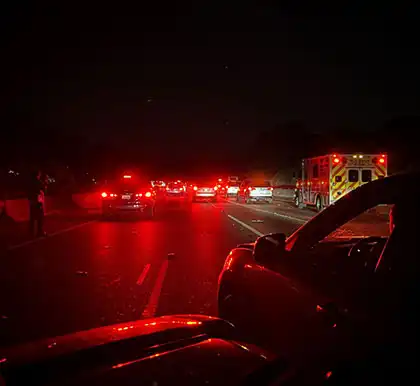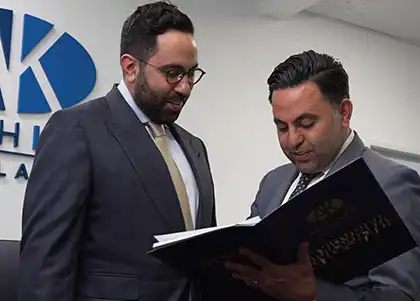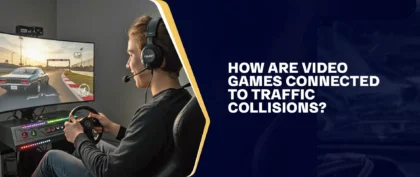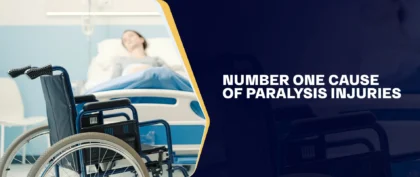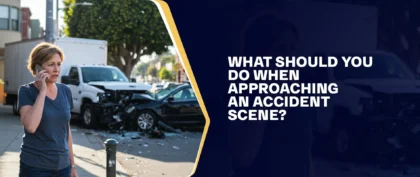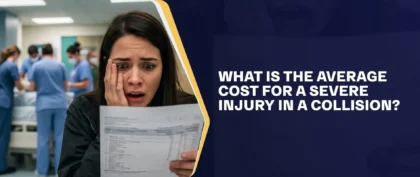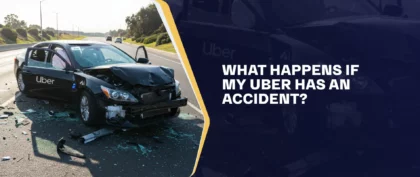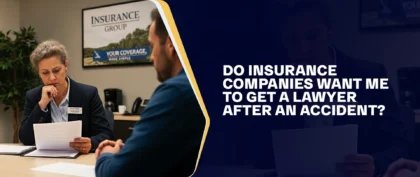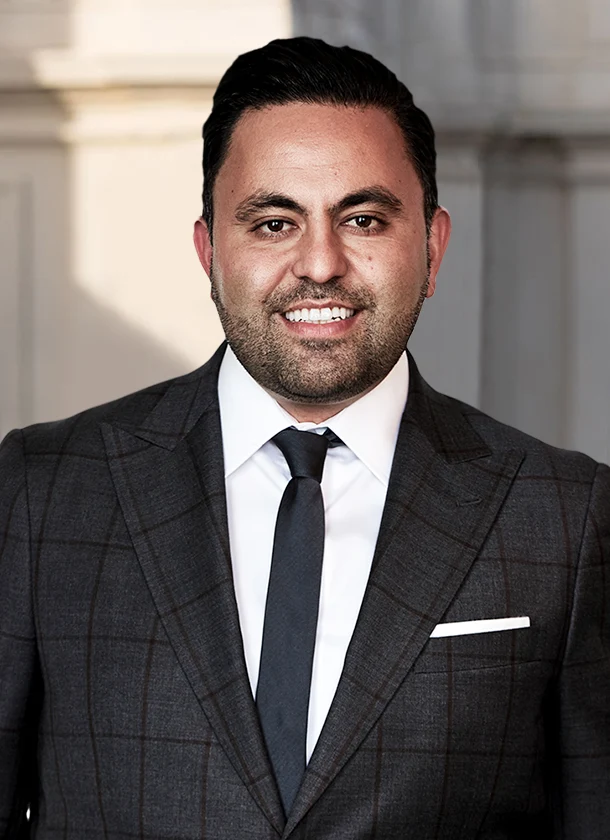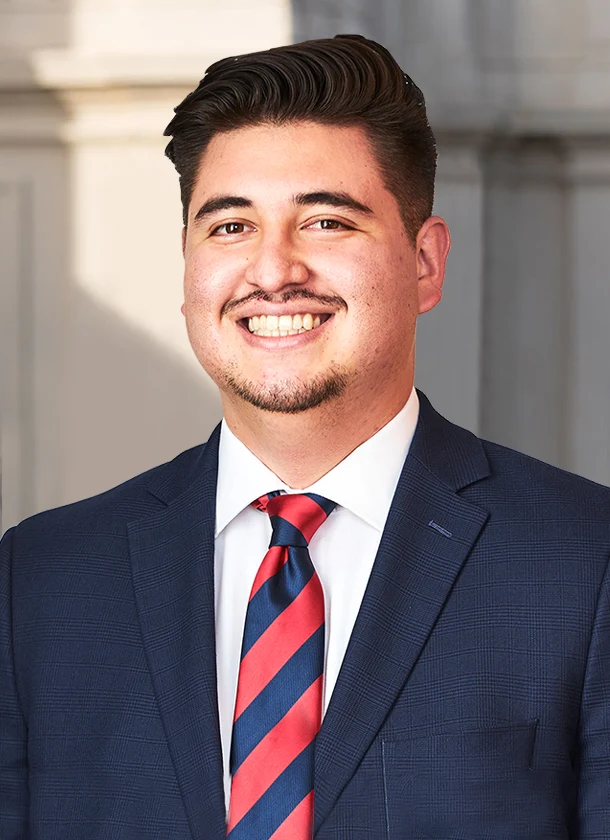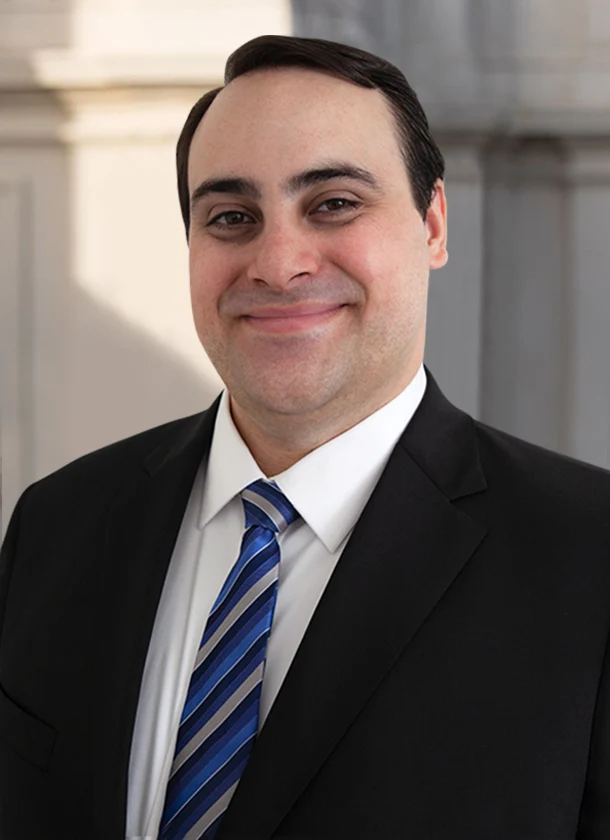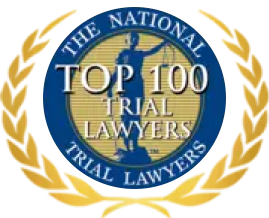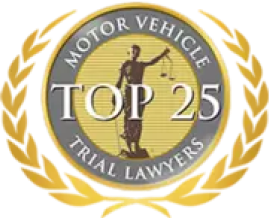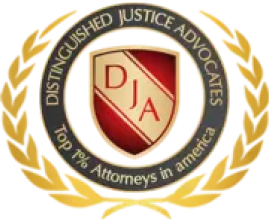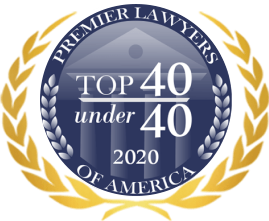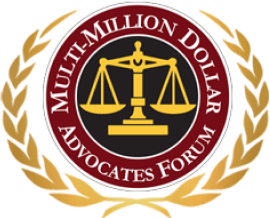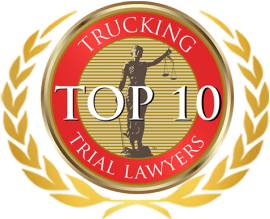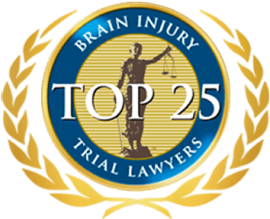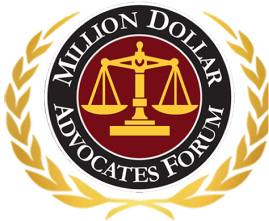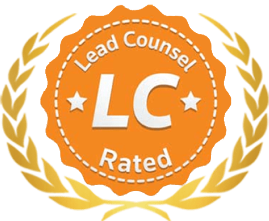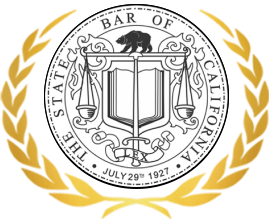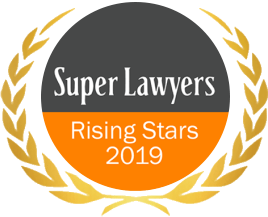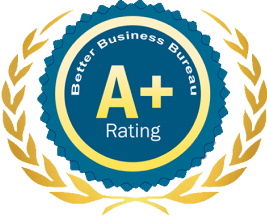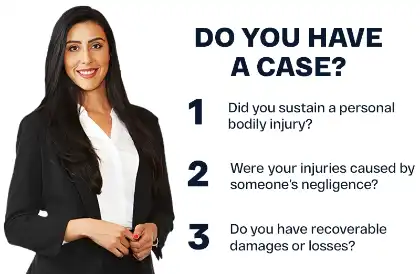TL;DR: Using emergency or hazard lights at night after an accident can be risky. They may cause glare, distract drivers, block first responders, or confuse autonomous vehicles. California law allows them only in specific emergencies. If emergency lights worsened your crash, call Arash Law at (888) 488‑1391 for free legal help.
Table of Contents
Using emergency or hazard lights at night can create new dangers if not handled properly. While they serve to alert others to a roadside emergency, their brightness may impair visibility, confuse approaching drivers, or interfere with safe navigation around the scene.
At night, flashing lights can also make it harder for first responders to see clearly or for autonomous vehicles to interpret what’s happening. Leaving them on too long or using them when your vehicle no longer poses a threat may increase the chances of another accident.
If you were injured in a crash where emergency lights may have made things worse, our car accident lawyers at AK Law can investigate what happened and help you understand your legal options. Call (888) 488-1391 for free accident lawyer advice.
Potential hazards of using emergency lights at night:
- Disorients drivers due to excessive brightness.
- Causes confusion about whether your vehicle is moving or stopped.
- Obstructs or distracts emergency personnel.
- Confuses sensors in self-driving vehicles.
- Encourages unsafe pedestrian movement near the scene.
Understanding The Risks Of Using Hazard Lights At Night
According to the Federal Motor Vehicle Safety Standards (FMVSS), hazard lights let other drivers know that a vehicle is stopped or moving more slowly than surrounding traffic. They’re a useful warning signal that alerts others to approach with caution. According to the California Driver Handbook, you can also use it to warn other drivers if you see any accident or danger ahead.
California law allows drivers to use hazard lights when stopped on the roadway due to an emergency, such as a car accident. When used correctly, they give other drivers time to slow down or change lanes. However, if your car is safely out of the roadway and no longer poses a hazard, it’s best to turn off the lights to avoid confusion.
Hazard lights are helpful when used as intended, but they can be dangerous at night or in low-visibility conditions. Here’s why:
- They Can Reduce Visibility for Other Drivers — At night or in bad weather, hazard lights can reflect off rain or fog and create glare that makes it harder to see the road. This added glare can make rain accidents more likely, especially when visibility and traction are already reduced. Safer options include roadside flares, LED triangles, or warning beacons.
- They Can Distract Other Drivers — Hazard lights draw attention and may cause drivers to lose focus on the road, delaying their reaction to traffic, pedestrians, or obstacles.
- They Can Cause Rear-End Collisions — In low visibility, blinking lights may confuse drivers into thinking a stopped car is still moving, increasing the risk of a rear-end crash. Misuse can also contribute to head-on collisions if oncoming drivers misjudge lanes or road positions at night.
- They Can Confuse Autonomous Vehicles — Flashing hazard lights at night may trigger self-driving car accidents if onboard sensors misinterpret the signals, causing the vehicle to brake suddenly, stop in unsafe spots, or react unpredictably.
- They Can Block or Delay First Responders — Drivers who stop and activate their flashers in the wrong place may block access or reduce visibility for ambulances, fire trucks, or police trying to reach the scene. One study found that highly reflective gear and lights can make it harder for drivers to see responders near their vehicles.
- They Can Endanger Bystanders — Warning signals may prompt well-meaning people to stop and help, sometimes stepping into traffic or parking unsafely, putting themselves at risk.
Nighttime Hazard Light Use: What’s Safe And What’s Not
Hazard lights can help warn other drivers during emergencies, but using them incorrectly, especially at night, can cause confusion or even lead to accidents. The California Vehicle Code limits when these lights should be used. Here’s what you should and shouldn’t do:
Safe and Legal Uses:
- If Your Vehicle is Disabled in the Roadway — Turn on your hazard lights to alert others that you cannot move, especially in active lanes.
- Stopping in a Dangerous Location — Use hazard lights if you’re pulling over in a low-visibility area like a curve, shoulder, or dark roadside.
- While Briefly Pulling Off After a Crash — Flashers can signal that you’re exiting traffic due to an emergency.
- During Roadside Emergencies — If you have a flat tire, engine issue, health problem, or hazard lights, let others know you’re not parked intentionally.
- To Warn Of a Crash or Road Hazard Ahead — Use them to alert following drivers to slow down or approach with caution.
When Not to Use Them:
Misusing hazard lights can confuse other drivers, disrupt traffic flow, or even cause an accident. Here are everyday scenarios when it’s discouraged or prohibited under the California Vehicle Code.
- While Driving Normally — Don’t use hazard lights if you’re simply lost, unsure, or driving slowly without a clear emergency.
- While Making Turns — Hazard lights override turn signals, making it unclear which direction you’re going.
- During Quick Stops — Avoid using hazards just to run inside a store or drop someone off. This may mislead other drivers and block traffic.
- In Bad Weather While Moving — Use headlights or fog lights instead. Flashing hazards can make it seem like your vehicle is stopped or disabled.
- Once Safely Off the Road — Avoid leaving your hazard lights flashing for long periods, as they can cause confusion or drain your battery.
- Without Using Other Warning Tools — Don’t rely only on hazard lights. Use flares, warning triangles, or reflective beacons to improve visibility.
Used correctly, hazard lights can help prevent further accidents. Used carelessly, they may create new risks, especially at night when visibility is already reduced, and could lead to serious harm such as back injuries, head injuries, brain injuries, or even amputations.
Common Questions About Using Hazard Lights At Night During An Accident
Our car accident lawyers often hear questions about when and how to use emergency lights safely. Many people worry about doing the right thing after a motor vehicle accident, but flashing hazard lights can sometimes cause more confusion or even risk. Here are some of the most common questions we get from clients, broken down to help you stay safe and informed.
Is Using Emergency Lights Risky At Night At An Accident Scene?
It is common to use hazard lights after an accident to improve visibility and signal danger. However, improper use can cause issues like blinding oncoming drivers, distracting other drivers, creating confusion, and triggering dangerous responses from autonomous car sensors. Apart from emergency lights, people may use safety triangles to warn approaching traffic instead.
Is It Recommended To Leave My Hazard Lights On During An Accident Scene?
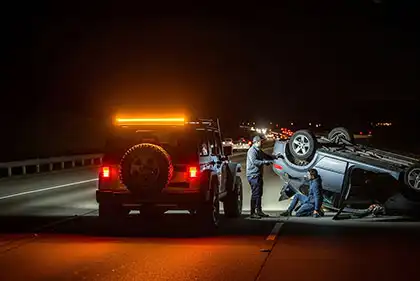
At night, those flashing lights can create glare, distract other drivers, or even hide the presence of people walking nearby, emergency responders, or good Samaritans. If dangerous road conditions are present, like heavy rain, fog, or debris, hazard lights can be useful to warn approaching traffic, but they should still be used carefully. Always think about visibility, location, and the flow of traffic. Call for help and let trained responders guide you on the next steps when you are in doubt.
What Should I Do If I’m The First At A Crash Scene?
Whether dealing with a minor fender bender or a serious collision, quick thinking and safe action may help improve safety at the scene. Here are some recommendations on what you should do after an accident to assist others while keeping yourself safe:
- Stay Calm — Take a deep breath. Staying calm will help you think clearly and act safely.
- Park Safely — Pull over at a safe distance. Turn on your hazard lights to warn other drivers.
- Check for Danger — Make sure it’s safe before getting out. Watch for fire, leaking fuel, or traffic.
- Call 911 — Even if the crash looks minor, call for help immediately. Give clear details about the location and what you see.
- Offer Comfort, Not Medical Help — Reassure the victims if they’re awake. Let them know that help is on the way, but avoid treating any injuries unless you have proper training.
- Keep the Area Safe — If you can, guide traffic from the scene until emergency services arrive. Use cones or flares if available, but don’t put yourself at risk.
- Stay Until Help Arrives — Stick around if it’s safe. First responders may need to ask what you saw.
If you get hurt while assisting at a crash scene, you may wonder, “Do I need a personal injury lawyer?” The truth is, these situations can quickly become legally complex. You were trying to help and not expecting to become a victim yourself. In such cases, accident lawyers can help you understand your legal options.
Injury attorneys can review what happened, explain your rights, and help you explore your options. If you are already in touch with one, you may get free accident lawyer advice from them based on your situation.
Flashing Lights Led To An Injury? Speak With Our Accident Attorneys
You use hazard lights during emergencies to stay safe, signal distress, or avoid further accidents. However, even when you’re careful, other factors such as distracted drivers, poor visibility, or multiple flashing lights may still contribute to accidents, especially at night or near active accident scenes.
If you were injured in a crash where hazard lights may have caused or worsened the situation, you can fill out our “Do I Have A Case?” form. Our lawyers for car accident cases can:
- Review what happened and explain your legal rights.
- Look into whether emergency lights were misused or created a hazard.
- Guide you through your options and next steps if you decide to pursue a claim.
We also handle different traffic accidents, such as:
- Truck accidents
- Bicycle collisions
- Pedestrian incidents
- Motorcycle crashes
- Rideshare accidents (e.g., Lyft & Uber)
- Semi-truck collisions
If your immigration status concerns you, you may still have legal rights. We can discuss your case regardless of your background. Call us at (888) 488-1391 or complete our contact form. Our team can guide you through your legal options and answer your questions about recovery.

